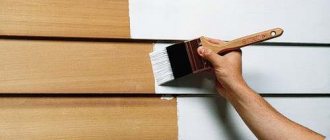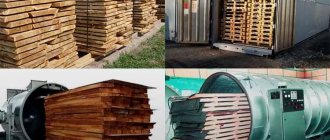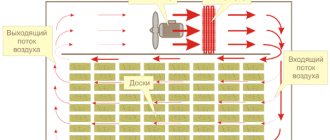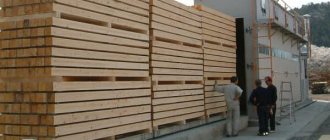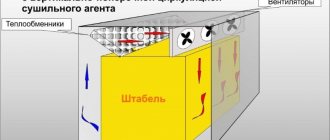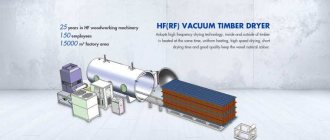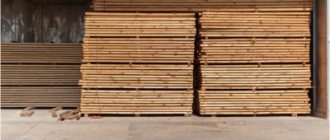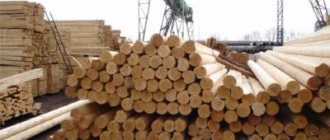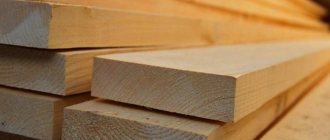Wood has been used in construction since ancient times. Despite the fact that the market is full of modern materials, it is very popular. This is explained by the fact that wood has many advantages and high performance properties. There are many factors to consider when using this material. This is especially true for his preparation. Shrinkage of lumber, a table that contains these values, affects their strength and durability.
Wood is a popular building material
Heterogeneity of drying
Drying wood is a rather complex and responsible process, since the properties of lumber will depend on it. Wood is an anisotropic material that has a heterogeneous structure. As a result, shrinkage carried out in different directions will be carried out differently.
In addition, various factors influence the process. First of all, it is worth noting the type of wood. Thus, lumber from deciduous and coniferous species dries out less than hardwood. No less important here is the method of storing wood. Shrinkage occurs in different ways:
- tangential – shrinkage in the direction of the annual layers is maximum and ranges from 8 to 12%;
- longitudinal - generally not taken into account, since it has a small value, which is 0.1%, and in the case of lurch wood - up to 5%;
- radial - this means shrinkage that occurs along the radius of the trunk and does not exceed 8%.
To understand how the process occurs, you need to disassemble it step by step:
- First stage. At this stage, a small part of the liquid is lost. It comes out slowly and partially. Evaporation occurs more slowly along the fibers. Despite this, the first stage is very important in preparing lumber for processing. This is especially true for expensive wood species.
- Second stage. Shrinkage occurs in longitudinal and radial projection. In the latter case, the parameters differ depending on the type of raw material. At this stage, the properties of the material change in the radial direction.
- Third stage. The final stage at which volumetric drying occurs. At this stage, the volume of moisture removal is determined, as well as the final state of the raw material. The main indicator is the shrinkage coefficient.
Even though the process is carried out using similar technology, the result will be different. Such unevenness leads to deformation of the raw material. This is a significant drawback, as it creates some difficulties in its processing in the future. First of all, this concerns changes in the geometric dimensions of wood. Changes in shape and cross-section result in increased waste during processing.
Important! It is worth considering that all work is carried out only with completely dried wood. It is impossible to work with wood that has not been fully dried.
Lumber is pre-dried and processed
Manifestation of wood shrinkage anisotropy in practice
Table of the ratio of shrinkage and swelling coefficients of wood.
As a result of shrinkage anisotropy, not only the geometric dimensions of wood change. Often this process is accompanied by a change in the shape of the workpiece. If wood shrinks unevenly, this can directly affect the quality of the wood material.
In this case, the likelihood of drying defects is very high. Such processes manifest themselves most clearly during chamber drying. This type of wood drying is the most common and effective today.
Thus, it is worth saying that at enterprises that dry wood, there must be a control process, which consists of maintaining stable values of temperature and humidity in the chamber.
In this case, there is a very high probability of reducing the occurrence of defects in finished products. In modern reality, the task at hand is quite easy to cope with.
Nowadays, a lot of equipment is being produced that is capable of automatically monitoring the state of the atmosphere inside the drying chamber. Of course, it is not cheap, but the likelihood of defects due to shrinkage is zero.
Modern temperature sensors that are installed in chambers are capable of operating with minimal error. This is achieved through the use of high-quality materials in the production process. Their error is often less than a tenth of a percent.
This is quite enough to carry out automatic control inside the furnace. The signal from all sensors is sent to a microcontroller, which is capable of performing hundreds of operations per minute.
If there is a sharp decrease or increase in temperature in any part of the chamber, the controller will react to this instantly. It transmits a signal to the actuator, which issues an alarm to the operator. In this way, the automatic drying process becomes more and more perfect.
Diagram of a chamber for drying wood.
If any technological processes are disrupted during the production process, there is a very high probability that the resulting product will be of poor quality.
All such cameras work taking into account the experience that was obtained experimentally by scientists. They examined most types of wood for shrinkage.
As a result of the data obtained, it is possible to debug the heating process in the furnace. Most enterprises that dry wood in chambers rely on this data.
Theoretical calculations
In the process of preparing wood, it is important to know the approximate parameters of its change. This will make it possible to prepare material that will be as close as possible to the required dimensions. Of course, such calculations are theoretical and may not have some deviations. This is due to the fact that it is difficult to foresee the deformation of raw materials during the drying process.
So, to determine the amount of moisture that leaves the wood, use the following formula:
M = Pbas. ( WН – WК ) / 100
M (kg/m3) – the amount of liquid that is removed from a cubic meter of wood;
Rbase. (kg/m3) – wood density, which is determined by the ratio of the mass of dry material to the volume with a moisture content of more than 30%;
WН and WК – wood moisture content before and after drying, respectively;
In addition, during the wood harvesting process, the percentage of its shrinkage is taken into account. It is calculated using the following formula:
U = K (30 – WK)
Y (%) – percentage of shrinkage;
K (%) – coefficient, which is taken from specially designed tables;
WK (%) – wood moisture content after drying.
During drying, deformation of materials and changes in geometric dimensions are possible.
Grouping of different types of wood
Shrinkage of wood in various parts of the trunk.
The level of volumetric drying of wood affects the division of natural species into the following categories:
- Weak degree of shrinkage. Moderate volume reduction. Significant level. Intensive amount of change.
When liquid appears on the surface of the wood, it begins to increase in volume and swell.
As is clear, this process is the opposite of the sample under consideration. Such phenomena are associated with the structure of lumber and its interaction with moisture. Swelling occurs as a result of an increase in the humidity of the raw material to 30%.
Some experts may claim that the natural phenomena in question are considered negative indicators, but this is not entirely true. Winemakers take advantage of these excellent characteristics, preserving the unity of oak barrels throughout the long shelf life of alcoholic beverages.
During the construction process, wood shrinkage has an important function; these indicators should be taken into account when constructing any structure from this valuable material. Otherwise, it will become an example of flaws and shortcomings.
Shrinkage coefficient
This coefficient indicates the relative changes in lumber dimensions as a result of a 1% decrease in moisture content. Depending on the direction of drying, it can be:
- tangential;
- radial;
- voluminous.
For each wood this parameter has its own meaning. Here are the coefficients of some breeds:
| Wood | Coefficient | ||
| Tangential | Radial | Volume | |
| Spruce | 0,31 | 0,17 | 0,48 |
| Maple | 0,32 | 0,2 | 0,56 |
| Beech | 0,35 | 0,18 | 0,53 |
| Scots pine | 0,31 | 0,18 | 0,49 |
| Linden | 0,33 | 0,23 | 0,56 |
| Poplar | 0,28 | 0,14 | 0,42 |
| Oak | 0,29 | 0,19 | 0,48 |
When making calculations, it is very important to pay attention to the fact that each wood has its own coefficient. This will allow you to more accurately learn the characteristics of changes in raw materials during the drying process.
When drying you need to follow some rules
Allowances
Based on numerous studies, state standards have developed tables that determine the shrinkage allowances for wood of a particular species. In the process of their creation, not only the type of raw material was taken into account, but also the type of sawing. However, there are some peculiarities of the calculations.
If the moisture content of the raw materials is below 30%, then allowances are based on the difference between the moisture readings given in the table and the actual one. In addition, calculations can be carried out using specially developed formulas, which take into account the type of wood and the method of sawing it.
Important! If the wood has a moisture content of less than 35%, then the actual indicator is included in the formula. This will allow drying to obtain the material of the required size.
The importance of taking into account home shrinkage
If the frame of the house does not sit for the required time for shrinkage, then there is a high probability that the window and door frames may warp and the floors, walls and ceilings will begin to twist.
Moving into a home prematurely can also cause uneven settlement. What does this mean and what is it fraught with? For example, one room will be heated more, another less, and the third will not be heated at all. As a result, cracks will begin to form in the structures, and the house may warp. Gaps in the walls will lead to heat loss. Thus, holes with a total area of 4% of the total volume will give a 25% reduction in the heat capacity of the wall.
Allowances for tangential and mixed sawing of fir, spruce, cedar and pine
Before considering shrinkage allowances, you need to understand what mixed and tangential sawing is:
- Tangential. The most popular type of sawing logs. As a result, you can obtain durable and practical lumber that is highly resistant to swelling and shrinkage. The material shows a sophisticated pattern of rings. It is widely used in the design of buildings. This technology is widely used in the production of high-quality parquet.
- Mixed or semi-radial. No less popular is the method by which lumber is produced. The cut is made at an angle of 45 degrees. The advantage is that you can save raw materials and thereby reduce the cost of finished products. The only negative is the high risk of deformation due to improper drying. Therefore, this process is approached with all responsibility. Coniferous and leaf species are used as raw materials.
As for the allowances themselves, a table has been developed for this, which takes into account the nominal size of the material and the final moisture content. All this should be taken into account when carrying out theoretical calculations. This is the only way to obtain a value that is as close as possible to the final parameters of the lumber.
The dimensions of the workpieces affect the drying process
Allowances depending on thickness and width
As already noted, drying wood is a rather complex and no less responsible process, in which many nuances should be taken into account. In this case we are talking about the following factors:
- wood species;
- cutting method;
- storage method;
- board sizes.
The size of lumber is no less important a parameter when processing wood than the species or features of the cut. All this has a direct bearing on the final result. Therefore, at the initial stage, it is necessary to take into account all these factors that will affect the receipt of material ready for further processing.
The pattern here is quite simple. According to it, the smaller the width and thickness of the board, the smaller the allowance for shrinkage. It should be taken into account that overall dimensions also affect the drying speed of raw materials, as well as the risk of deformation during this process.
Advantages of wood (natural):
Despite some problems arising from warping of wood, this material can be preferred to others due to its advantages such as high strength and frost resistance, low thermal and sound conductivity, ease of disposal and ease of processing. In addition, wood has a low coefficient of linear expansion under the influence of temperature.
Disadvantages of wood (natural):
Among the disadvantages inherent in wood, we can list such as the presence of knots and cracks, hygroscopicity, and flammability. Let us note right away that the shortcomings are eliminated with the help of special technologies. Consider, for example, hygroscopicity. Being a capillary-porous material, wood has the ability to both release and absorb moisture from the environment. Therefore, wood owes its shrinkage-swelling properties precisely to its hygroscopicity. This can lead to both a change in the size of parts and structures made of wood, and to the development of destructive microorganisms - fungi. In order to eliminate hygroscopicity, the surface of wooden structures is coated with water- and air-tight compounds: varnishes, paints, etc.
Allowance table
| Wood | Material dimensions, mm | ||||||
| 16 | 25 | 40 | 60 | 100 | 130 | 160 | |
| Deciduous | 0,6 | 0,9 | 1,4 | 2,1 | 3,5 | 4,5 | 5,6 |
| Coniferous | 0,6 | 0,8 | 1,2 | 1,8 | 2,8 | 3,9 | 4,1 |
As you can see, coniferous wood is less subject to deformation and changes in size. This is due to the structure of the tree and the presence of resins and other components in its composition. In any case, all these parameters are taken into account when calculating the possible sizes of lumber after drying.
What determines the amount of wood shrinkage?
The factors influencing the amount of wood shrinkage include the following:
- Material - log, rounded log, timber, laminated veneer lumber. A house made from hand-cut logs shrinks up to 15 cm, from rounded logs - up to 10 cm, from timber - up to 6 cm. Kiln-dried profiled timber shrinks - 2.5-4 cm, laminated timber - 1.5-2 cm.
- Intercrown sealant - moss, jute, flax, tow and others.
- Material size. Naturally, the larger the part, the greater the shrinkage.
- Initial moisture content of wood.
- Construction technology, type of felling. For example, if the logs do not fit tightly when hand-cut, the shrinkage may be so significant that you will have to add several additional crowns so that you can move comfortably in the house.
- It's the time of year when construction is underway. In summer, the log house requires up to 12 months to shrink. Log houses erected in winter require 2 times less shrinkage time - about 6 months.
